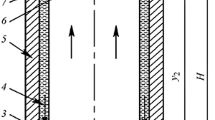Abstract
Boiling heat transfer characteristics of a two-phase closed thermosyphons with various helical grooves are studied experimentally and a mathematical correlation is developed to predict the performance of such thermosyphons. The study focuses on the boiling heat transfer characteristics of two-phase closed thermosyphons with copper tubes having 50, 60, 70, 80, 90 internal helical grooves. A two-phase closed thermosyphon with plain copper tube having the same inner and outer diameter as those of grooved tubes is also tested for comparison. Water, methanol and ethanol are used as working fluid. The effects of the number of grooves, various working fluids, operating temperature and heat flux are investigated experimentally. From these experimental results, a mathematical model is developed. In the present model, boiling of liquid pool in the evaporator is considered for the heat transfer mechanism of the thermosyphons. And also the effects of the number of grooves, the various working fluids, the operating temperature and the heat flux are brought into consideration. A good agreement between the boiling heat transfer coefficient of the thermosyphon estimated from experimental results and the predictions from the present mathematical correlation is obtained. The experimental results show that the number of grooves, the amount of the working fluid and the various working fluids are very important factors for the operation of thermosyphons. Also, the thermosyphons with internal helical grooves can be used to achieve some inexpensive and compact heat exchangers in low temperature.
Similar content being viewed by others
Abbreviations
- A:
-
Surface Area (m2)
- b:
-
Distance between grooves (m)
- cp :
-
Specific heat (J/kg.K)
- Dt :
-
Inside diameter (m)
- e:
-
Height of groove (m)
- g:
-
Gravitational acceleration (m/s)
- h:
-
Heat transfer coefficient (W/m2.K)
- hfg :
-
Latent heat of vaporization (J/kg)
- k:
-
Thermal conductivity (W/m.K.)
- L:
-
Length of thermosyphon (m)
- m:
-
mass flow rate (kg/s)
- P:
-
Pressure (Pa)
- Q:
-
Heat transfer rate (W)
- Q:
-
Heat flux (W/m2)
- T:
-
Temperature (K)
- ΔT:
-
Tw-Tl (K)
- w:
-
Width (m)
- ρ:
-
Density (kg/m3)
- μ:
-
Dynamic viscosity (N.s/m2)
- φ:
-
Liquid fill charge ratio (%)
- atm:
-
Atmosphere
- avg:
-
Average
- c:
-
Condenser
- e:
-
Evaporator
- hot:
-
Heating water
- i:
-
Internal
- in:
-
Inlet
- l:
-
Liquid
- out:
-
Outlet
- p:
-
Plain
- sat:
-
Saturated
- v:
-
Vapor
- w:
-
Wall
References
Abdel-Aziz, M., 1996, “ Experimental Analysis of the Optimum Performance of Closed Vertical Thermosyphon Based on Geometry and Liquid Fill Rate Considerations,” The 9th Int. Conf. For Mech. Pewer Eng., (ICMPE.9), Shebin El-Kom, Egypt, December, pp. 21–24.
Boo, J. H. and Jung, Y., 1988, “Experimentson the Thermal Performance of a Thermosyphon in Inner Grooved Copper Tube,”Proc. SAREK Summer Conf., pp. 313–317.
Chen, Y., Ding, X. and Yu, J., 2004, “Study on Heat Transfer Oscillation Phenomenon and Restraining Method of Two Phase Closed Thermosyphons, ”13 th International Heat Pipe Conference, Vol.2, pp. 30–310.
Hashimoto, H., Kaminaga, F. and Matsumura, K., 1999, “Study on Condensation Heat Transfer Characteristics in a Thermosyphon with Non-Condensable Gas Effect,”11 th IHPC, Vol. 1, pp. 121–126.
Hideaki, I., Kenji, I. and Shigetoshi, I., 1999, “An Experimental Investigation of Geysering in Two-Phase Closed Thermosyphons,”11 th International Heat Pipe Conference-Tokyo, Vol. 1, No. 1, pp. 166–1771.
Imura, H., Kusuda, H., Ogata, J.L., Miyaz, T. and Sakamoto, N., 1997, “Heat Transfer in Two-Phase Closed-Type Thermosyphons,”Trans, of Japan Soc. of Mech. Engrs., pp. 485–493.
Kim, C. J., Yoo, B. O. and Park, Y., J., 2003, “An Experimental Study of a Closed Two-Phase Thermosyphon with Two Evaporators in Parallel Arrangement,”Proceeding of the the 7 th International Heat Pipe Symposium, Jeju, Korea, G-4.
Kline, S. J. and McClintock, F. A., 1953, “Describing Uncertainties in Single-Sample Experiments,”Mechanical Engineering, Vol. 75, pp. 3–8.
Kusuda, H. and Imura, H., 1993, “Boiling Heat Transfer in an Open Thermosyphon.”JSME, Vol. 16, No. 101, pp. 1734–1740.
Peterson, G. P. and Ma, H. B., 1996, “Experimental Investigation of the Maximum Heat Transport in Triangular Groove,”ASME J. of Heat Transfer, Vol. 35, No. 3, pp. 740–746.
Sarhaan, H. H., 2000, “Flow and Heat Transfer in Wickless Heat Pipe,”Ph.D Thesis, Mansoura University.
Shalaby, M. A., Araid, F. F., Sultan, G. I. and Awad, M. M., 2000, “Heat Transfer Performance of a Two-Phase Closed Thermosyphon,”Proceeding of the the 6 th International Heat Pipe Symposium, Chiang Mai, pp. 269–278.
Terdtoon, P., Ritthidej, S. and Shiraishi, M., 1996, “Effect of Aspect Ratio and Bond Number on Heat Transfer Characteristics of an Inclined Two-Phase Closed Thermosyphon at Normal Operating Condition,”Proceedings of the 5 th International Heat Pipe Symposium, Melbourn, Australia, pp. 261–266.
Author information
Authors and Affiliations
Corresponding author
Rights and permissions
About this article
Cite this article
Han, K., Cho, DH. Theoretical and experimental studies on boiling heat transfer for the Thermosyphons with various helical grooves. J Mech Sci Technol 19, 1662–1669 (2005). https://doi.org/10.1007/BF03023942
Received:
Revised:
Issue Date:
DOI: https://doi.org/10.1007/BF03023942




